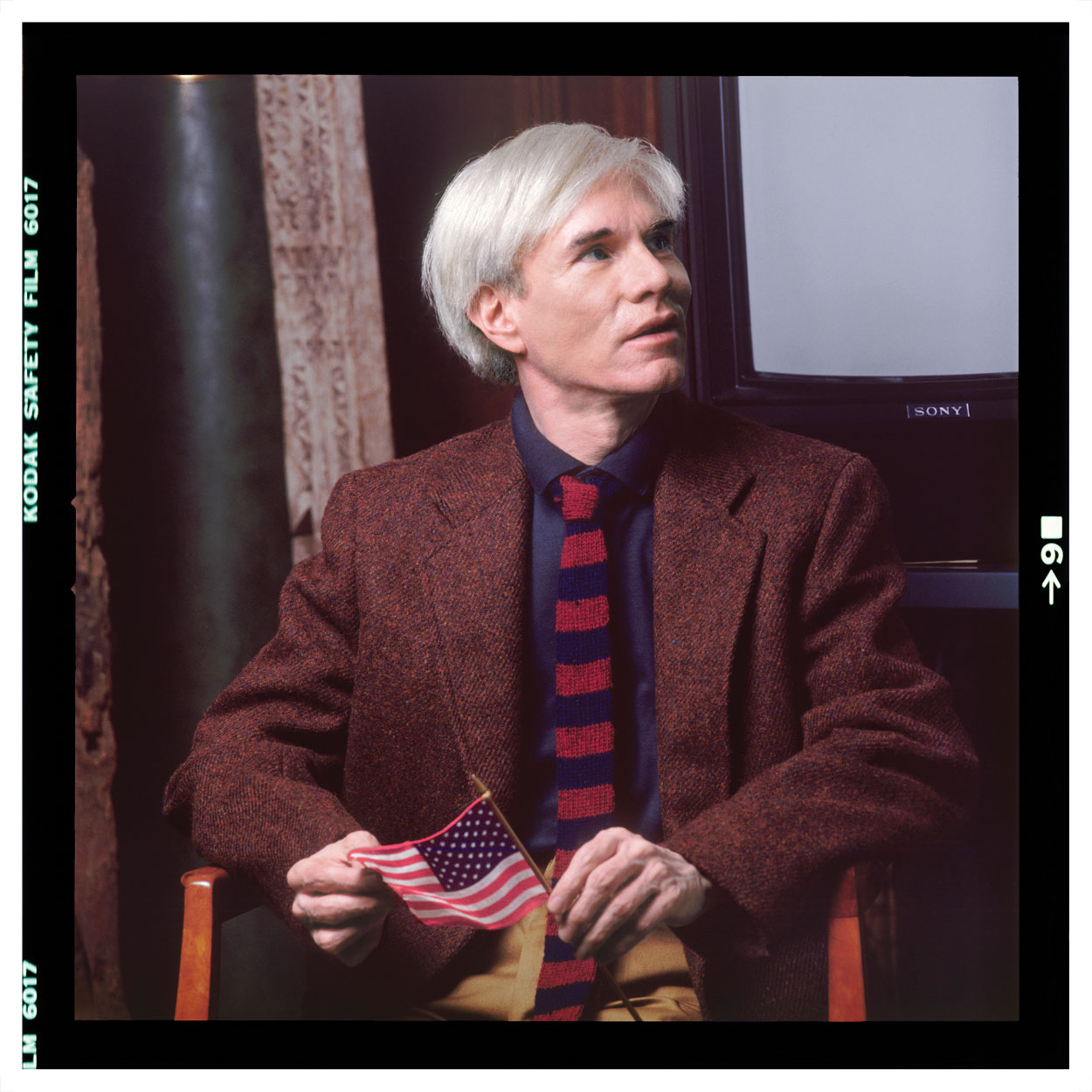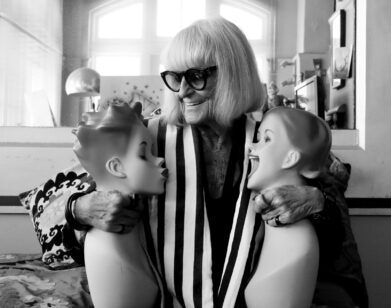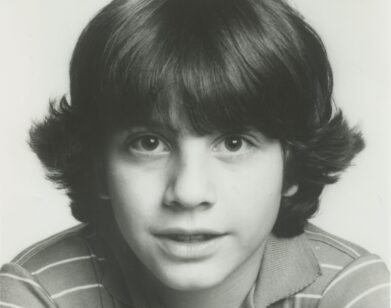Photographer Karen Bystedt remembers shooting Andy Warhol as an NYU student
Karen Bystedt, who has made a career of photographing actors like Brad Pitt, Keanu Reeves and Johnny Depp when they were still just pretty mugs knocking on the doors of Hollywood, had perhaps her most career-making encounter when she was still a student at New York University. Bystedt rung up the Interview offices in 1982, and to her surprise, Andy Warhol answered the phone in his baby voice. She convinced him to sit for a portrait in the magazine’s conference room when it was still located at Union Square. She also interviewed Warhol and published the resulting portraits in a book of male models titled Not Just A Pretty Face in 1983.
Then, fait accompli, she stored away the negatives and forgot about them. Until 2011, when she saw a Warhol artwork fetch $100 million at auction and decided it was time to dig them up. To her horror, most of the 36 negatives were eaten away by termites or covered in termite poop and it took a painstaking pixel-by-pixel process of Photoshop magic to bring ten of The Lost Warhols back to their former glory. Now, returning to the city where she originally photographed the Pope of Pop Art, Bystedt is exhibiting the original images as well as a number of reworks of the photos by artists Tommii Lim, Dom Pattinson, and Peter Tunney, among others. Here’s how it all began.
KAREN BYSTEDT: I was probably 17 or 18 when I first saw Andy Warhol. I was a club kid when I was 17. I would go to Area, Limelight, Nell’s … Then I somehow started photographing male models. I was gonna be a film student, and I had this boyfriend who had a camera and he had me photograph him. I fell in love with it. I took a photography class and started photographing all my friends, and then someone heard about me and asked if I would test. He said he’d buy the film. So we did three rolls, and he took them to his agency and I went in there and showed them my portfolio. And [the agency] said, “You’re really good with men.”
I was very cultured, so of course I knew who Andy Warhol was. I even saw him and Basquiat once at a gallery opening in Chelsea, huddled in the corner. But I got the idea to photograph [Andy] when I was perusing through GQ magazine to look for models. I saw an ad at Barney’s with him modeling. He had this white wig, and I thought, wouldn’t it be great to have Andy in a book on male models? I knew he was at Interview magazine and I knew people around him, but I didn’t know him himself. But once I saw him in the ad I wanted him as a model in the book, which was called Not Just Another Pretty Face. So I called Interview magazine—apparently André Leon Talley was answering the phone then—but Andy answered the phone, which was crazy. Like, unheard of.
I recognized his voice because he had a very specific voice. He spoke very slowly, almost like a baby. I said, “Look, this is Karen Hardy”—that’s my maiden name—“and I would love to photograph you as a model for this book I’m working on.” He just said, “Oh, really? Who else do you have?” I said, “Well I have—” I rattled off a bunch of names. I had two of the Calvin Klein underwear guys, I had the Ralph Lauren guy. So then he said okay, and we set it up.
I’d been photographing everyone else with a Nikon at sunset, and I’d been doing body shots, with their shirts off. But of course, I wasn’t gonna do that with Andy! Now I might’ve had the courage to say, “Let’s take it off.” [laughs] Anyway, I rented a Hasselblad, because Robert Mapplethorpe was using a Hasselblad, and I wanted, out of respect, to photograph Andy with a Hasselblad. He met me in the [magazine’s] conference room. He was wearing a tweed Perry Ellis suit. I guess Perry Ellis was one of his favorite designers. He had put on his own makeup. It was really bad. He had caked it on, so I actually had to ask him if I could help him spread it around a little. First, he literally jumped back, because I don’t think people touched him, but I really wanted to make him look as good as possible. Then he said, “I wish everyone would do that because I wanna do those day jobs and hang out with all the beautiful models and get paid the day rates. Instead, they’re all afraid to touch me, and they just book me for half an hour and just shove me in the shot.” [laughs] So that was it.
I also interviewed him for the book. One of the things he said was that he had been in a store in Paris and this guy that worked there was staring at him and he thought, “Well, this guy must be staring at me because I’m Andy Warhol or something.” That’s how he said it: “Or something.” But the guy came up to [him] and said, “Aren’t you the model that was in the Barney’s ad in GQ?” And he said, “That made my day, it made my week, it made my year.” I always thought it was so crazy that Andy Warhol, who was such a famous figure, had agreed to photograph with me. I hadn’t even been published. He didn’t even ask to see my work, he just let me in.
In the book I did this thing called vital statistics with all the models, and in all the vital statistics boxes. Instead of putting people’s nicknames—like Matt—I would’ve put Matthew. So for Andy, I put Andrew. [laughs] Some of the things I asked were: “What are your favorite hobbies?” He said, “Everything I do is a hobby.” I said, “What’s your age?” “Boys don’t have to tell their age anymore.” Who’s your hero? “Walt Disney.” Favorite movie? “Coming attractions.” Just the coming attractions, that was his favorite movie. He was quick, but very slow and deliberate in the way he delivered. It was almost cartoon-like. While he was talking you were like … “Wow. What is he saying?” It was very confusing, the way he delivered it, but it was all brilliant.
[At some point] I lost track of the negatives. I believe I gave them to a photo agency, but they never did anything with them. Then I read a story about how Andy had just sold something for 100 million and a lightbulb went off. I was like, “Oh shit, I have to go find the negatives.” For about a week I looked and then I finally found some of them in a cardboard box. Not even metal or plastic. Termites ate them. They were big negatives in wax sleeves. Some of the sleeves were okay, but some of them the termites had eaten through. Then I was introduced to a guy who was in the archival department at the J. Paul Getty Museum, who scanned them on $50,000 machines up at the museum. I hired him, and for four months we sat there and I watched him restore the images back pixel by pixel. I’ve never seen anything like it. I retouch, but this is crazy. Seriously, we were just looking at pixels. Then what happened was, because there was dirt or whatever it was as we were fixing, Andy started to look better. So it almost went into retouching, and I had to make the creative artistic decision to be okay with that. I feel like Andy always wanted to look beautiful, and I did photograph him as a model, so I made the artistic decision to make him look as good as possible.
My idea was to do a cohesive show in New York City, where I photographed him, with the right people. And then I was introduced to God’s Love We Deliver, one of the largest charities in New York City. I really wanted to do a cohesive show of my photographs and all these incredible interpretations that other artists have done, making Andy Warhol into the art.
THE LOST WARHOLS: BRINGING ANDY HOME IS ON VIEW UNTIL MAY 22, 2018 AT ONE VANDAM, 178 AVENUE OF THE AMERICAS.







